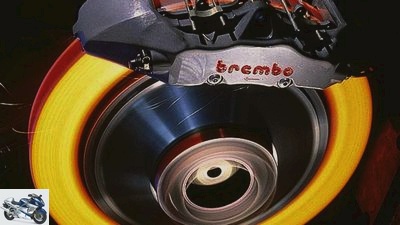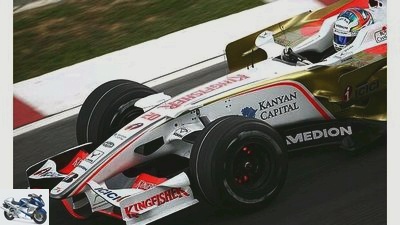Table of contents

Brembo
Sports & scene
Motorsport
Brake performance in comparison: MotoGP versus Formula 1
Brake performance in comparison: MotoGP versus Formula 1
At the limit
Content of
A factory visit to Brembo, brake supplier for Formula 1 and MotoGP teams, enabled a look behind the scenes and an exclusive data comparison of the braking behavior in the two premier classes.
Sebastian Lang
01/26/2009
At the limit
“Valentino I think.” Ask Eugenio Gandolfi, Sales Manager Brembo Racing, after the toughest brakeman in MotoGP, he answers clearly. He should know: the polite Italian has been traveling the world with his team for over 20 years, looking after the Formula 1, MotoGP and Superbike World Championship stables, discussing possible further developments and interpreting data. A stressful job that results from Brembo’s unique monopoly in motorsport and enables comparisons that would otherwise be inconceivable: a comparison of the braking performance of a Formula 1 driver and that of Valentino Rossi, for example. But before that, a factory visit to the traditional Italian company is on the agenda. The journey leads to Bergamo, more precisely: to the Kilometro Rosso Science Park, named after the red wall that was built along the large industrial site. The color is not the only reference to Brembo. The company name also comes from a valley near Bergamo. Legend has it that a member of the Brembo Bombassei family had a car accident there in the 1950s and had to wait days for new brake discs. He then decided to produce these himself in the future.
Of course, the anecdote can be enjoyed with a wink, but since the company was founded in 1961, the company has continued to develop. Almost all well-known automobile and motorcycle manufacturers work with Brembo as a brake supplier, albeit partly under their own flag. The brake calipers of a sports car manufacturer in Zuffenhausen boast their own company name, but the pliers themselves come from Brembo. In addition, there is a large accessories market with all imaginable parts from the brake pump to the brake pad – and finally motorsport. All Formula 1 and almost all MotoGP teams drive parts of the Brembo Group, which also includes AP and Marchesini, so the quality standards are correspondingly high. Brembo apparently spares no expense or effort to live up to this special position. The production of the raw material for Rossi’s brake calipers from aluminum and expensive lithium alone takes eight months, for example, and that of the carbon brake discs takes a good six months. On the other hand, the carbon fiber parts weigh 1.4 kilograms less than the steel discs that are used in the Superbike World Cup.
In order to always be up to date with the latest technology, Brembo employs almost ten percent of its 5700 employees in research and development. The test stands and production machines are correspondingly impressive: Gandolfi proudly strolls past huge metal boxes in which Formula 1 brake discs are red-hot and pushed to their limits. He explains state-of-the-art computer-controlled five-axis milling machines that form beautifully curved MotoGP brake calipers from a solid block of metal. A dream for every technology fan, an almost inconceivable effort for every controller.
Brake test

2Snap
The formula racer can be compressed much later and harder than the race bike thanks to the higher drive and larger tire contact area.
And how hard does he brake now, Mr. Rossi? Brembo’s response was emailed a few days later. A numbered sketch of the Barcelona Grand Prix circuit and a table with braking data from Formula 1 and MotoGP reveal some secrets from the company’s own data: The difference between the two classes is even greater than expected. For example at the end of the start / finish straight. Although the eight-time world champion decelerates with a maximum of 15.67 m / s², i.e. 1.6 times the acceleration due to gravity, according to a calculation by Brembo, he needs 336 meters to brake his Yamaha from 300 km / h (V2) to 105 km / h (V2) Felippe Massa can only smile about these values in his Ferrari: At full throttle he flies past Rossi’s braking point and hits the iron much later. 112 meters are sufficient for the Formula 1 racing car to decelerate from 311 to a corner-ready 146 km / h. The deceleration values are correspondingly higher: the pilot is pressed into the seat belts with up to 4.3 g when braking.
The temperatures of the brake discs can reach up to 950 degrees Celsius in some corners of the circuit in northern Spain – no wonder that Barcelona Brembo is considered an extremely stressful track internally. Thanks to the higher downforce and larger tire contact area, the four-wheeler can be compressed much later and harder than the race bike. The ten-cylinder can accelerate correspondingly longer and therefore reaches slightly higher speeds than the two-wheeler before you step on the brake pedal – this can be seen in the table as V1. The only exception is braking point 6, in front of which an additional chicane is built in at the Formula 1 Grand Prix, which is not used in MotoGP. When the brakes are released – V2 – sometimes the motorcycle, sometimes the racing car, is faster. A result of the different driving styles: Rossi pulls a total of 27.5 seconds on the Brembo lever per lap over 1286 meters, while Felippe Massa needs 15.5 seconds of braking time and 578 m on the same route. Even the toughest brakeman in MotoGP does not even come close to achieving the braking performance of a racing car – despite the feather-light and outrageously expensive top material.
Related articles
-
Exhaust tuning and performance comparison at Akrapovic
Bilski 27 pictures fact 1/27 Three parameters mainly determine the potential of a bend: the diameter of the pipes, their shape and length. Akrapovic 2/27…
-
New Brembo racing brake system for the World Superbike
WSBK 6th pictures WSBK 1/6 The WSBK’s new brake calipers are derived from MotoGP. Cooling fins are milled into the body for the hot races. WSBK 2/6 As…
-
Downhill comparison bike versus motorcycle
motorcycles Downhill comparison bike versus motorcycle Downhill comparison bike versus motorcycle Completely crazy You plunge down the steepest slopes at…
-
What matters when it comes to MotoGP brakes
PSP / LukaszSwiderek 12th pictures 2snap 1/12 2snap 2/12 The rear brake is hardly required for decelerating. However, it often functions as a…
-
Report: A factory visit to the brake specialist Brembo
wolf 12th pictures wolf 1/12 Laboratory check: problem cases such as brake fading are simulated on 18 test stands. wolf 2/12 Disc wheel? No, Gianluca has…
-
Ralf Petersen counselor workshop Brake system screwdriver tips Brake system screwdriver tips Everything on stop If you want to move forward quickly, you…
-
Mid-range naked bikes in a comparison test
fact 23 pictures fact 1/23 The middle class has changed. 100 hp, at least 750 cc and 200 km / h are nothing unusual here. fact 2/23 We test three…
-
Petronas Yamaha MotoGP Team: Rossi and Morbidelli
Sepang Racing Team (SRT) Sports & scene Motorsport Petronas Yamaha MotoGP Team: Rossi and Morbidelli Petronas Yamaha MotoGP Team Valentino Rossi and…
-
MotoGP Safety Cars & Safety Bikes 2021 from BMW
18th pictures 1/18 BMW has been providing the MotoGP security fleet since 1999. We’ll show you which models have been converted into safety cars and…
-
Comparison test 125cc: Aprilia RS 125, Honda NSR 125 R
motorcycles Comparison test 125cc: Aprilia RS 125, Honda NSR 125 R Comparison test 125: Aprilia RS 125, Honda NSR 125 R The perfume The air becomes thin…